Sperm Whale
Physeter macrocephalus
Holds breath for up to 90 minutes at a time
Advertisement
Sperm Whale Scientific Classification
- Kingdom
- Animalia
- Phylum
- Chordata
- Class
- Mammalia
- Order
- Cetacea
- Family
- Physeteridae
- Genus
- Physeter
- Scientific Name
- Physeter macrocephalus
Read our Complete Guide to Classification of Animals.
Sperm Whale Conservation Status
Sperm Whale Facts
- Prey
- Squid, sharks, skates, fish
- Group Behavior
- Pod/Solitary
- Fun Fact
- Holds breath for up to 90 minutes at a time
- Estimated Population Size
- 300,000 to 450,000
- Biggest Threat
- Human activity, climate change
- Most Distinctive Feature
- Size and huge head
- Distinctive Feature
- Cone-shaped teeth and enormous body size
- Other Name(s)
- Cachalot
- Gestation Period
- 14 to 16 months
- Optimum pH Level
- 6 - 9
- Habitat
- Ocean
- Predators
- Sharks, Humans, Killer Whales
- Diet
- Carnivore
- Average Litter Size
- 1
- Favorite Food
- Squid
- Type
- Cetacean Common nam
- Common Name
- Sperm Whale
- Number Of Species
- 4
- Slogan
- Each tooth weighs 1kg!
View all of the Sperm Whale images!
The sperm whale, also known as the spermaceti whale or cachalot, is the largest of the toothed whales.
Found in all of the world’s oceans, sperm whales were once hunted extensively; a moratorium on such activity in the late 1980s has helped their populations to grow again. Despite their colossal size, sperm whales can move at speeds of up to 23 miles per hour and dive to depths as far as 10,000 feet.
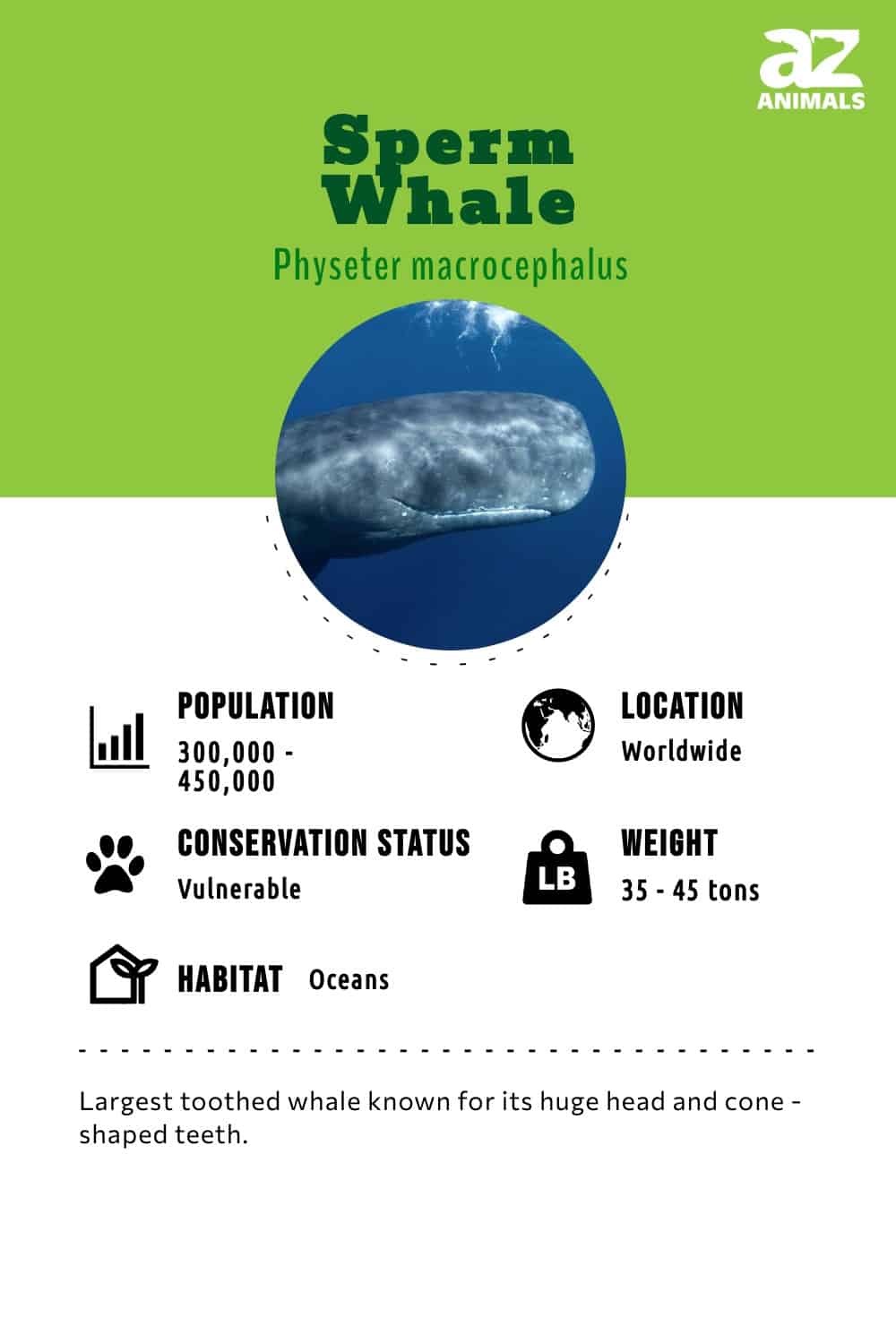
5 Incredible Sperm Whale Facts!
- When diving for food, these whales can hold their breath for up to 90 minutes at a time.
- Their massive tail fluke, measuring an average of 16 feet from end to end, allows them to travel in bursts of up to 23 miles per hour.
- Two other species of sperm whale exist but are relatively unknown – the pygmy sperm whale and the dwarf sperm whale.
- These whales will dive up to 3,280 feet to find food, and their skeletons show pitting that may be indicative of decompression sickness.
- Female sperm whales form lasting bonds with other females, forming social units that often last entire lifetimes.
Make sure to read ‘10 Incredible Sperm Whale Facts‘ to get the full rundown of amazing facts on these massive whales!
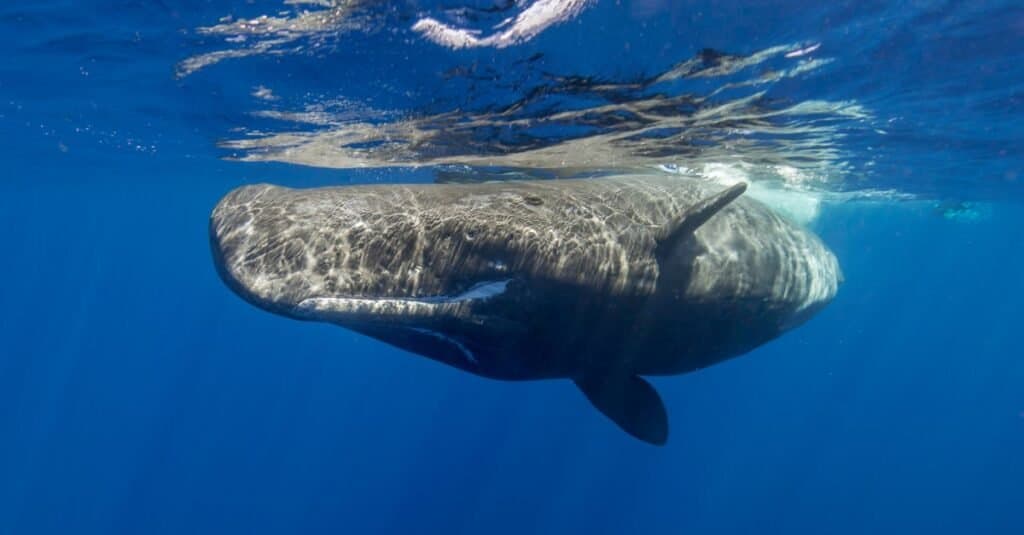
A Sperm whale’s head takes up a third of its body.
©wildestanimal/Shutterstock.com
Classification and Scientific Name
Sperm whales belong to the class Mammalia, the order Cetacea, the family Physeteridae, and the genus Physeter. The scientific name for this cetacean is Physeter macrocephalus; the word Physeter is derived from a Greek word that means “blower,” which refers to the whale’s blowhole. The word macrocephalus means “big-headed,” which refers to the creature’s massive head, which makes up nearly one-third of its skeleton. This whale is also known by the specific name Physeter catadon; the word catadon means “down tooth,” which refers to the fact that only the bottom teeth erupt while the top remains beneath the gums.
The sperm whale is also called a cachalot, which may be derived from an archaic French term meaning “big teeth” or a Portuguese word meaning “big head.”
Evolution
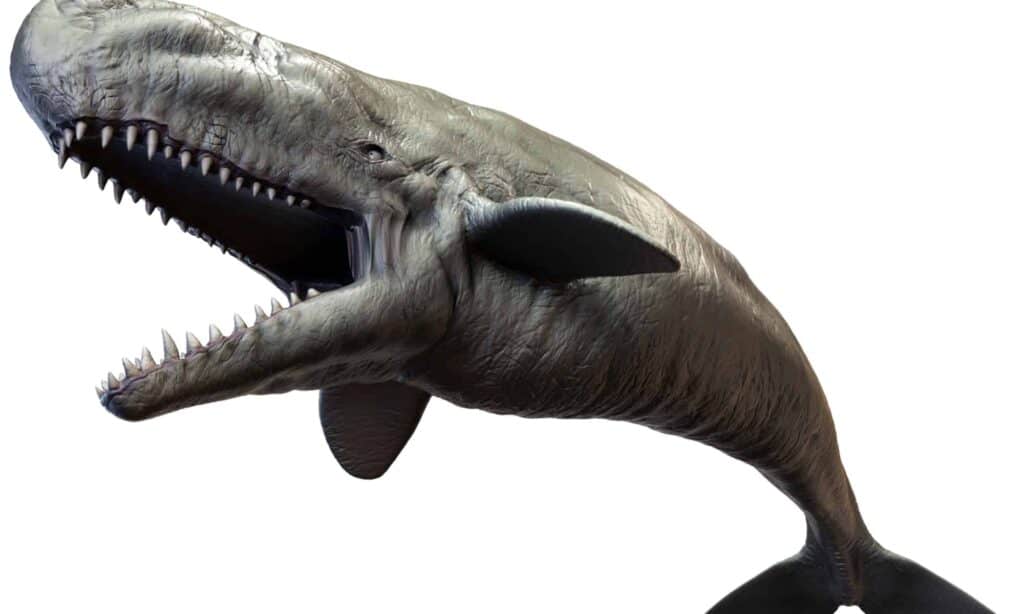
Livyatan mellvillei is an ancient ancestor of the sperm whale with one of the largest bites in the history of life on earth.
©Herschel Hoffmeyer/Shutterstock.com
During the middle of the Miocene epoch, around 12 million years ago, two giant predators roamed the seas. Megalodon was the ancient ancestor of the shark – a much bigger, more vicious version of the great white shark of today. The other gargantuan killer was the ancestor of the sperm whale, Livyatan mellvillei, about the same size as the modern bull sperm whale – but with one of the largest bites in the history of life on earth.
Livyatan’s giant head and mouth had evolved to equip the animal with the bite needed to capture, kill and consume baleen whales – its main source of food. Scientists believe that Livyatan and Megalodon were as important to Miocene marine ecosystems as orcas and great whites are today. Present-day sperm whales retain the giant head and teeth, as well as the organ referred to as spermaceti – an oil-filled sac prized by whalers. Its purpose in Livyatan and in sperm whales is still unknown.
Species
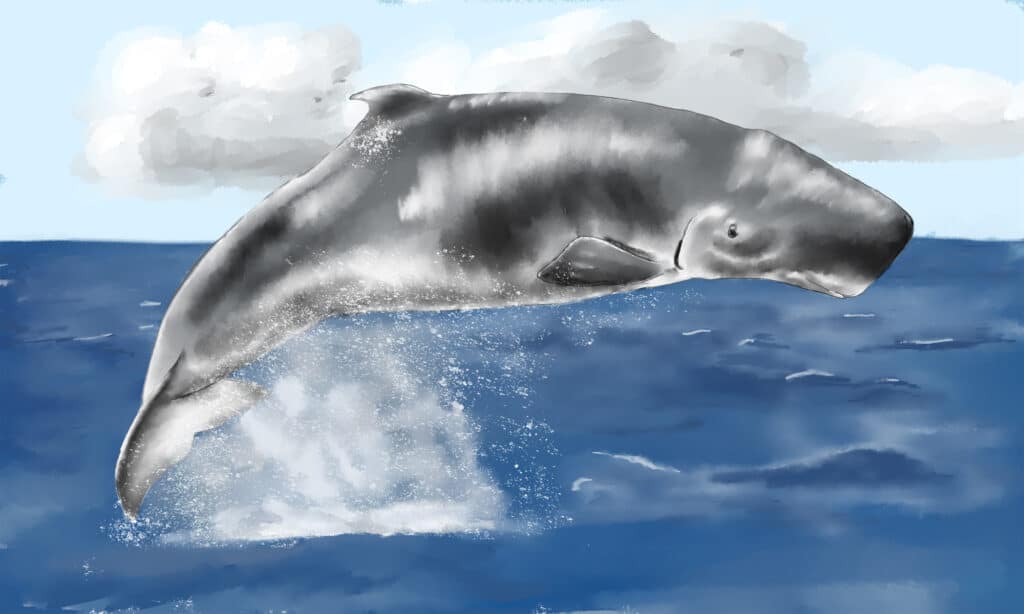
This whale is the only living member of the genus Physeter, and it is one of three living species in the sperm whale family, Physeteridae. The other two species in that family are the pygmy sperm whale, Kogia breviceps, and the dwarf sperm whale, Kogia simus. Reminiscent of dolphins, pygmy, and dwarf sperm whales measuring between 8 and 13 feet long and featuring grey bodies and white bellies.
Appearance
The largest toothed predators on earth, these whales grow to a size of 49 to 59 feet in length and between 35 to 45 tons in weight. Males grow to an average size of 52 feet and 45 tons while females grow to an average of 40 feet and 15 tons. Their massive heads – their skulls make up about one-third of their skeletons – feature prominent, rounded foreheads and narrow lower jaws. The head houses the largest brain of any creature on earth – it weighs up to five times more than a human brain – along with large quantities of spermaceti, oily fluid that turns waxy when cold. Once thought to be sperm, the substance remains somewhat mysterious to scientists. Some believe that spermaceti may help these whales alter their buoyancy for more effective diving, but its exact purpose is unclear.
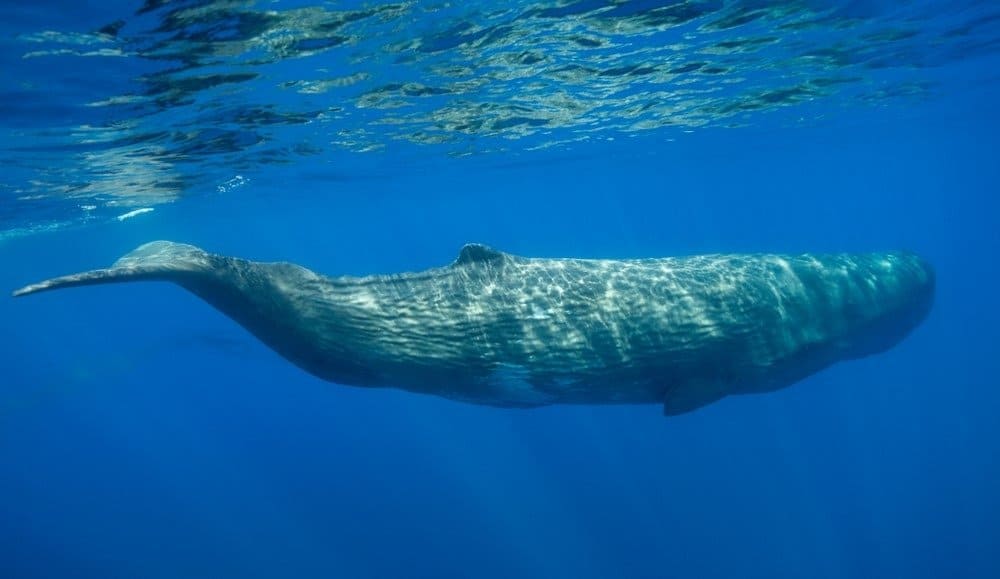
The sperm whale is the only living creature with an asymmetrical blowhole on the left side of its head.
©wildestanimal/Shutterstock.com
The skin behind the head is normally wrinkled, and the skin across the body is typically dark grey; some whales have white patches on their bellies.
This whale is the only living creature with a single, asymmetrical blowhole, which is found on the left side of the crown of its head. The interior of their mouths is usually bright white, and 20 to 26 large teeth are found on either side of the lower jaw; the teeth along the top rarely erupt from the gums. Sperm whales have paddle-shaped flippers, small dorsal fins, and small, triangle-shaped flukes. However, its tail fluke can measure up to 16 feet long from tip to tip, allowing it to travel in short spurts at speeds of up to 23 miles per hour.

Sperm whale breaching off the coast of Pico Island, The Azores, Portugal.
©wildestanimal/Shutterstock.com
Distribution, Population, and Habitat
Sperm whales have one of the broadest global populations of any marine animal species. Heavily targeted by whalers primarily during the 18th and 19th centuries, their population declined drastically until a moratorium was called in 1986 by the International Whaling Commission. Since then, it is believed that their population levels have increased again. No official accounting is available, but it is estimated that there are anywhere from 300,000 to 450,000 sperm whales in the world today. This whale is classified as Vulnerable by the IUCN.
These toothed predators are found in all of the world’s oceans. However, their populations tend to be found primarily in waters near Alaska, New England, the Mid-Atlantic, the West Coast, and the Pacific Islands.
Predators and Prey
Predators
These whales do not face any true predators in the wild. However, young or injured whales may be hunted by killer whales or orcas.
While they don’t face much in the way of natural predators, these whales face numerous threats that are mostly caused by humans. These include becoming entangled in fishing gear; vessel strikes; marine debris; oil spills and other types of contamination. Noise pollution from ships and other human activities interrupts their behavior and may impact their survival. Climate change is also believed to be one of the biggest threats to these creatures.
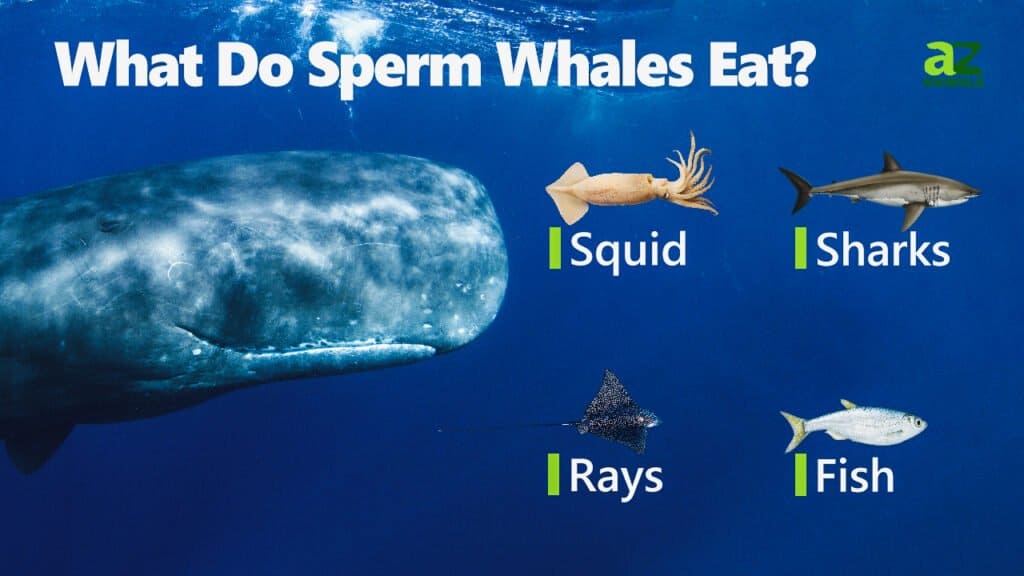
Prey
As carnivores, sperm whales’ diets consist almost entirely of other creatures. They mostly target larger species, and their diets are mostly made up of sharks, skates, squid, and fish. They can eat up to one ton, or between 3 and 3.5 percent of their body weight, per day.
Reproduction and Lifespan
The average lifespan for these whales is around 60 years. Female whales and young male whales live together in pods of between 15 and 20 individuals, while mature male sperm whales tend to travel solo or move from group to group.
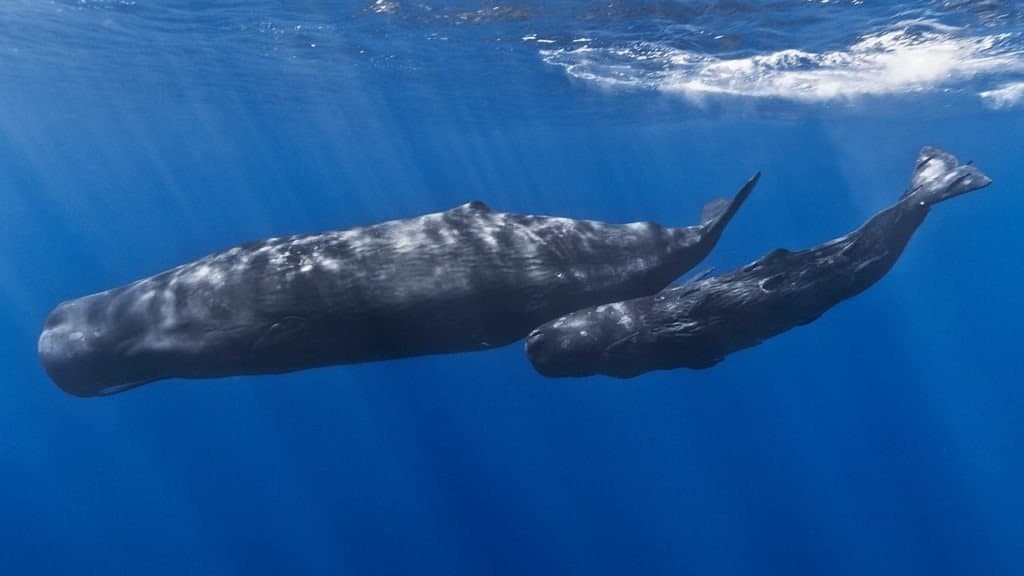
Female sperm whales are believed to engage in communal childcare.
©Gabriel Barathieu / CC BY-SA 2.0 – License
Females and young males stay in tropical and subtropical waters throughout the year, and they are believed to engage in communal childcare. However, Males tend to migrate toward higher latitudes alone or in groups before returning toward the equator to breed. Female sperm whales reach sexual maturity at around nine years of age or about 29 feet in length; they reach physical maturity at around 30 years or about 35 feet in length. Females produce one calf every five to seven years, on average. After a gestation period of 14 to 16 months, a calf measuring an average of 13 feet in length is born. They can start eating solids at around one year of age, but they often continue nursing for many years.
Male sperm whales stay the same size as females for roughly the first 10 years of life. However, they continue to grow substantially until well into their 30s. They reach sexual maturity in their late 20s and physical maturity at about 50 years, or at about 52 feet in length. Males typically leave their pods between the ages of four and 21 years; they often join “bachelor schools” made up of other males around the same size and age. As they age, they start migrating toward the poles, making trips back to tropical waters to breed.
Sperm whales are known for being vocal, and they make lots of sounds. Indeed, their sounds can measure up to 530 decibels. Sometimes, they make sounds to communicate; other times, they do so for echolocation purposes.
The average lifespan for a sperm whale is about 60 years.
Whale Oil
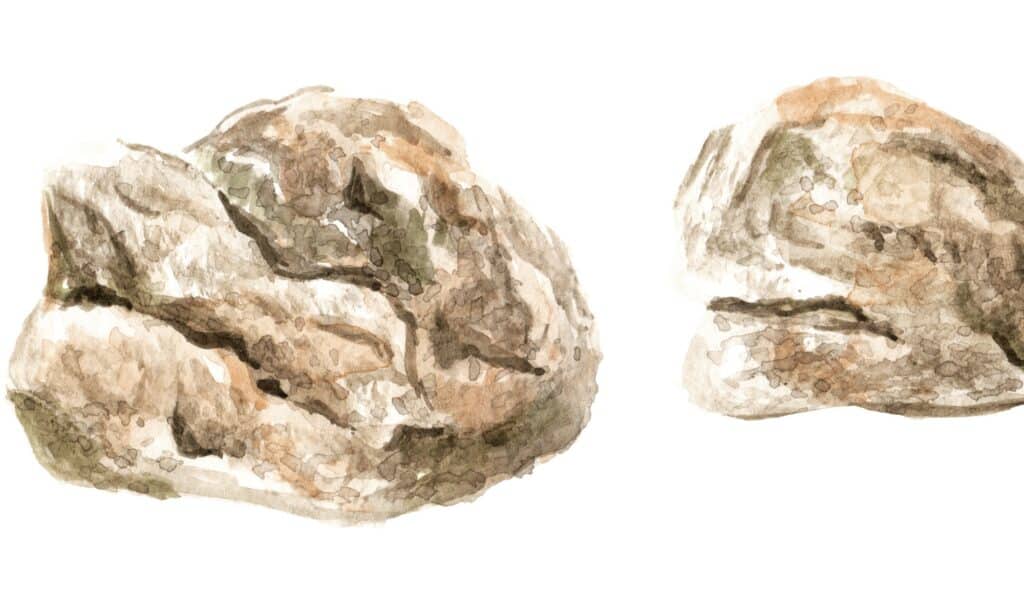
Ambergris from the sperm whale is still used in perfumes.
©iStock.com/Daria Ustiugova
Sperm whales were once hunted extensively for their spermaceti, which was used in candles, oil lamps, and as a lubricant. They were also targeted for their ambergris, which is believed to develop in their stomachs around squid beaks, which was used – and still is used – in perfumes. However, a moratorium was enacted on targeting these creatures in the late 1980s. They have never been popularly consumed as food.
View all 293 animals that start with SSperm Whale FAQs (Frequently Asked Questions)
Where is the sperm whale found?
Sperm whales are found in all of the world’s oceans. However, their populations are most highly concentrated in the Pacific Islands, Alaska, America’s West Coast, New England, and the Mid-Atlantic.
How big is a sperm whale?
The sperm whale grows to an average of 49 to 59 feet long and 35 to 45 tons.
Why is it called a sperm whale?
Whale hunters during the 18th and 19th centuries believed that the oily substance found in sperm whales’ heads was sperm, so they called the substance spermaceti and the whale the spermaceti whale. It has since been shortened to just “sperm whale,” even though the substance is not, in fact, sperm.
Do sperm whales eat humans?
Sperm whales are fairly peaceful creatures, and recordings of sperm whale attacks are exceedingly rare and usually only occur to ships – not to actual humans.
Are sperm whales dangerous?
Although they are carnivores, sperm whales are not considered to be dangerous. They are known for being placid creatures, and they only seem to attack humans when they mistake them for squid or other traditional prey.
Are Sperm Whales herbivores, carnivores, or omnivores?
Sperm Whales are Carnivores, meaning they eat other animals.
What Kingdom do Sperm Whales belong to?
Sperm Whales belong to the Kingdom Animalia.
What phylum to Sperm Whales belong to?
Sperm Whales belong to the phylum Chordata.
What family do Sperm Whales belong to?
Sperm Whales belong to the family Physeteridae.
What order do Sperm Whales belong to?
Sperm Whales belong to the order Cetacea.
What genus do Sperm Whales belong to?
Sperm Whales belong to the genus Physeter.
What type of covering do Sperm Whales have?
Sperm Whales are covered in Smooth skin.
What are some predators of Sperm Whales?
Predators of Sperm Whales include sharks, humans, and killer whales.
What are some distinguishing features of Sperm Whales?
Sperm Whales have cone-shaped teeth and enormous bodies.
How many babies do Sperm Whales have?
The average number of babies a Sperm Whale has is 1.
What is an interesting fact about Sperm Whales?
Each tooth of a Sperm Whale weighs 1kg!
What is the scientific name for the Sperm Whale?
The scientific name for the Sperm Whale is Physeter macrocephalus.
What is the lifespan of a Sperm Whale?
Sperm Whales can live for up to 60 years.
How many species of Sperm Whale are there?
There are 4 species of Sperm Whale.
What is the biggest threat to the Sperm Whale?
The biggest threats to the Sperm Whale are human activity and climate change.
What is the optimal pH for a Sperm Whale?
The optimal pH for a Sperm Whale is between 6.0 and 9.0.
What is another name for the Sperm Whale?
The Sperm Whale is also called the cachalot.
How many Sperm Whales are left in the world?
There are between 300,000 to 450,000 Sperm Whales left in the world.
How fast is a Sperm Whale?
A Sperm Whale can travel at speeds of up to 23 miles per hour.
How do Sperm Whales have babies?
Sperm Whales give birth to live young.
Megalodon vs Sperm Whale: Who Would Win in a Fight?
A megalodon would win a fight against a sperm whale.
The megalodon has stealth and experience killing whales on its side, but a sperm whale has never encountered anything like this creature before. Sure, they can get harassed and killed by killer whales, but nothing that has the biting power and size of a megalodon has attacked a sperm whale in the world today.
Sperm Whale vs Orca: Who Would Win in a Fight?
A lone sperm whale would kill an orca in a one-on-one fight.
Even when both creatures travel in pods, the orcas typically choose to separate the smaller whales from the group and kill that rather than face the terrible fury of a bull whale.
Do whales poop?
Yes, whales poop.
What's the difference between sperm whales and blue whales?
Blue whales grow far larger than sperm whales. In addition, sperm whales feed using their teeth, while blue whales feed using a baleen.
What is the difference between humpback whales and sperm whales?
The key differences between a humpback whale and a sperm whale are their family, their size, appearance, diet, and their habitats. Sperm whales are usually smaller than humpback whales. Besides, the sperm whale has a general lifespan of 60 years while the humpback whale has a lifespan of 45 years to 50 years.
What are the differences between a colossal squid and a sperm whale?
The greatest differences between a colossal squid and a sperm whale are their size, range, and morphology.
Thank you for reading! Have some feedback for us? Contact the AZ Animals editorial team.
Sources
- Britannica, Available here: https://www.britannica.com/animal/sperm-whale
- NOAA Fisheries, Available here: https://www.fisheries.noaa.gov/species/sperm-whale
- National Geographic, Available here: https://www.nationalgeographic.com/animals/mammals/s/sperm-whale/#close

















